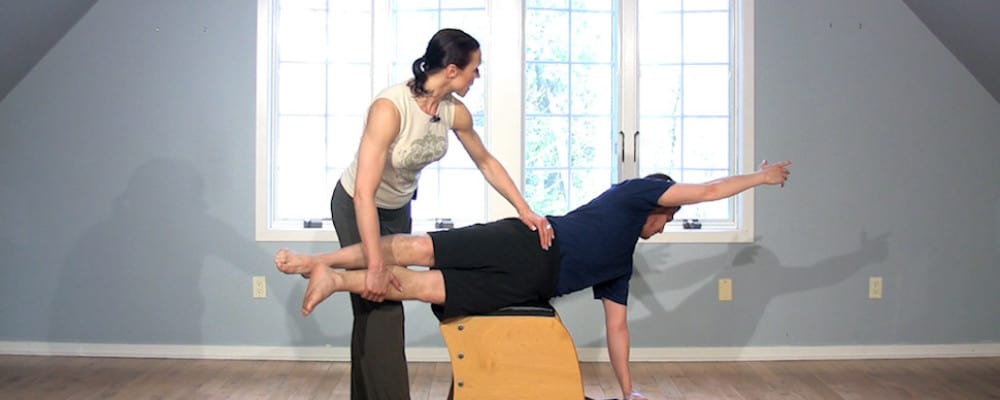One Pilates Exercise that will make all the other ones BETTER.

Joe Pilates said if you can do only one exercise a day, it should be the Double Leg Pull (sometimes called Double Leg Stretch). This exercise captures the very essence of the Pilates Method: the strong center, the 2-way stretch out of it, and the breath. Perform this exercise well and it will make all your other exercises better. Consider it your personal Pilates Mantra.
We only have one exercise:
The Double Leg Pull.
 The Double Leg Pull can be an excellent window through which to view every other Pilates exercise.
The Double Leg Pull can be an excellent window through which to view every other Pilates exercise.
If an exercise is indeed a Pilates exercise you will find the Double Leg Pull within it. Now you might end up upside-down and backwards with one arm and a twist, but the Double Leg Pull is still in there. (Which twisty one-armed, upside down exercise am I referring to here? Find out the answer at the end of this post.)
Conversely, if Double Leg Pull is nowhere to be found, perhaps the exercise in question is not really a Pilates exercise…
Awww… frownie face…
If I can find the Double Leg Pull how will it help my Pilates workout?
Marian Diamond, a neuroscientist and professor of neuroanatomy at the University of California at Berkeley maintains “The important thing that we’ve learned is that repetition helps memory. Teachers should know that it’s all right to say something once and then turn it around and say the same thing in another way, to use repetition.”
This is exactly what is happening in your workout. The Pilates Method (the teacher) is presenting your body and your brain with repetition: with the same set of circumstances (the Double Leg Pull) in an endless variety of different scenarios (all the other exercises).
And then you will do it all over again the next day, and the day after that. Et cetera. I know, Latin is so sexy. Let’s run with it.
Repetitio Est Mater Studiorum: Repetition is the mother of all learning (Study).
An example of learning by repetition is a child learning to ride a bike.
“The more attempts a child makes, the more the brain reinforces the particular skills necessary to stay balanced and in motion. After some time, the child doesn’t have to stop and think about each part of the procedure to stay upright, balanced, and in motion, or how to stop without falling off.
Every time the child rides, the skill is reinforced. Even years later, with no additional riding experience, it is possible for a person to get on a bike and ride because it was so firmly encoded in the brain. This is the power of learning by repetition.” from Professional Learning Board
The same holds true for encoding the Pilates Method on the body. Just like riding a bike, the more intrinsic Pilates is to your body, it then begins to inform all of your various daily activities and sports. All the exercises are really just exaggerated versions of everyday natural movements.
The ultimate result of the method is to have the skills cultivated in your body to such a degree that your every movement becomes a Pilates exercise.
So did you guess?
My choice for the upside-down-and-backwards-with-one-arm-and-a-twist version of the Double Leg Pull is the Twist on the Wunda Chair. Yup, it’s even got the breathing aspect, lookie there!
Related Posts:

mb008
Member since 2019
Thank you, Andrea! Have been reading on your blog about progressions, and really appreciate how you break things down.
Posted April 3, 2019 |